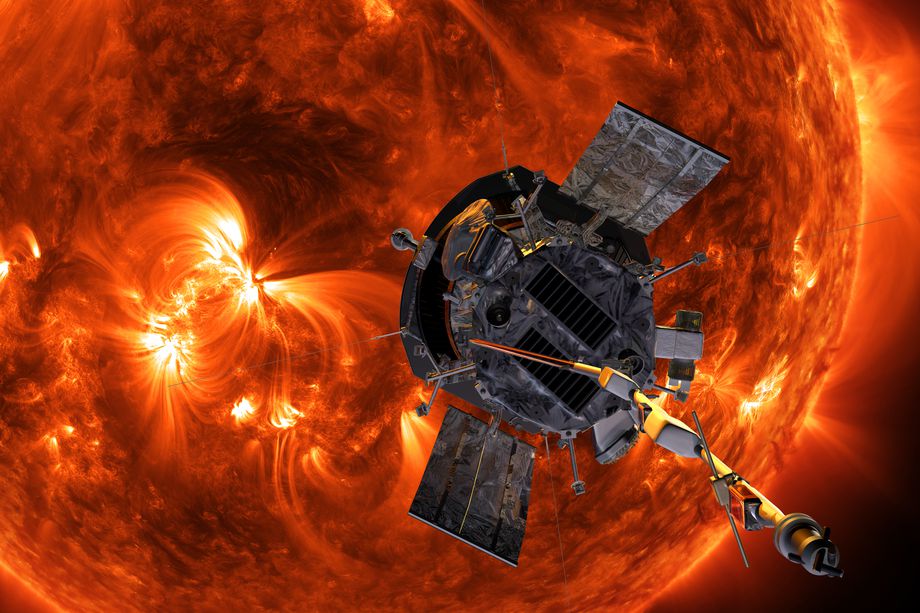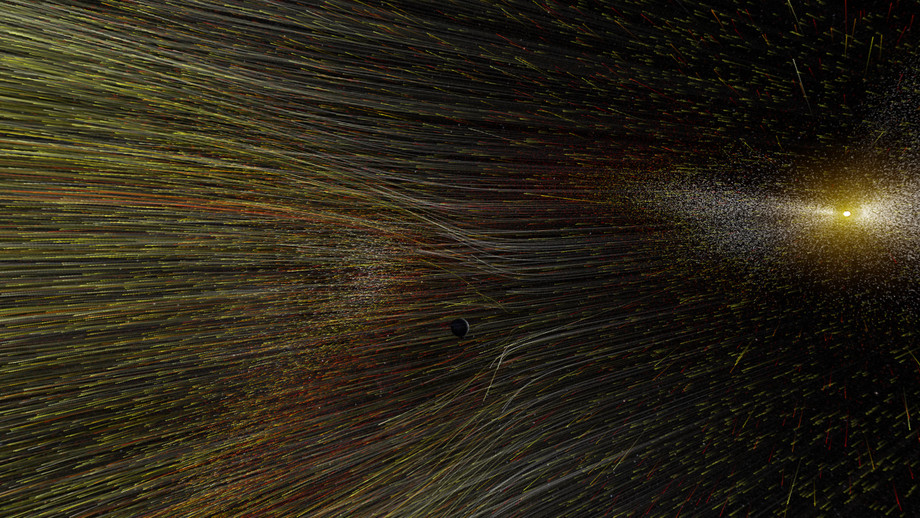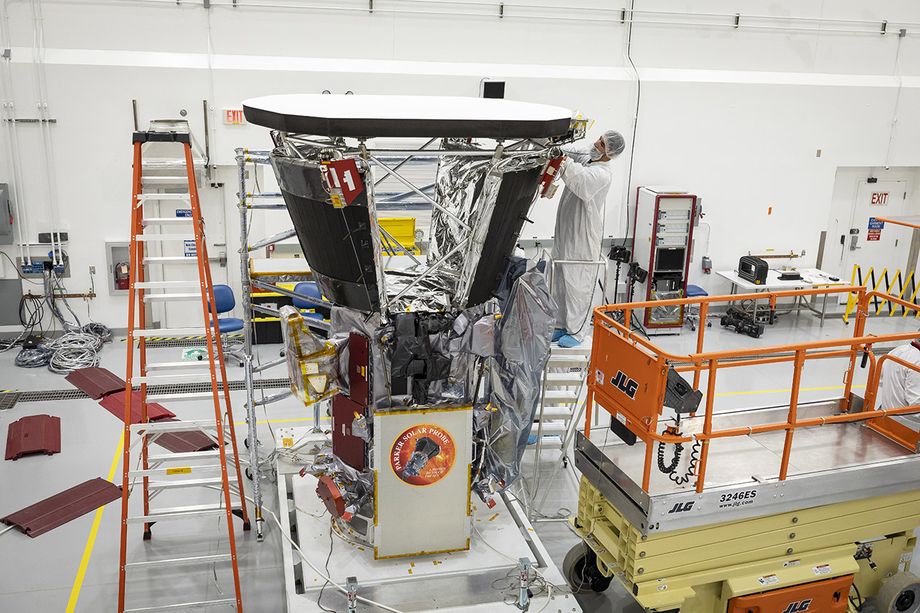The
Parker Solar Probe is getting closer to our star than any vehicle has before

In the wee hours of Saturday morning, a car-sized
NASA spacecraft will embark on its journey to the center of our Solar System, where it will mingle with the scorching hot atmosphere of our
Sun. The vehicle is the Parker Solar Probe, and it’s destined to get within 4 million miles of our parent star, which is closer than any other human-made artifact has reached before. From this vantage point, the probe is poised to solve mysteries about the Sun and its atmosphere that have plagued scientists for over half a century.
NASA has long wanted to send a vehicle to the Sun’s atmosphere, but such a mission has been considered impossible until the last few decades. This region of space, known as the corona, is filled with tiny, energetic particles that can reach above 3 million degrees Fahrenheit. Any vehicle that ventures near this region must have sophisticated protection to keep from melting. But thanks to advancements in carbon manufacturing and other key areas of engineering, NASA has been able to create a vehicle with a state-of-the-art heat shield and other crucial cooling systems. The result: the spacecraft will stay at room temperature in some of the hottest places in the Solar System.
The Sun’s corona is actually 300 times hotter than the surface of the Sun, and no one understands why. “If you think about walking away from a heat source or a campfire, you don’t suddenly get hotter. You get colder,” Nicola Fox, the project scientist for the Parker Solar Probe mission at Johns Hopkins University, tells The Verge. “So why does this happen?” The region gets so hot that chunks of the corona actually accelerate and break away from the immense pull of the Sun at supersonic speeds. These so-called solar winds shoot highly energized particles out in all directions, which then slam into surrounding planets.
Parker is tasked with investigating the mechanics of the breakaway effect and why the atmosphere is so much hotter than its source. “We’ve tried studying these things from Earth, and all of the signatures that we need to see, all the information, gets smeared out over the 93 million miles on the way to Earth,” Eric Christian, the senior research scientist at NASA’s Goddard Space Flight Center, tells The Verge. “We have to go where the action is.”
The mysterious coronaPlans to send a probe into the Sun’s corona date back to 1958 and the very start of NASA. At the space agency’s inception, a special committee listed 14 different missions that NASA should pursue, including visiting all the planets of the Solar System. All 14 missions have been accomplished in some form apart from one: a probe to visit near the Sun.

Just as NASA was setting its long-term goals, a young astrophysicist named Eugene Parker published a new theory about how stars release energy. He predicted that the atmospheres of stars like our Sun get so hot that they are continually flowing outward, bathing all the planets around them in particles. Parker came up with the term “solar wind” to describe this phenomenon. Most in the scientific community disputed the existence of solar winds until 1962 when a NASA spacecraft called Mariner 2 ventured out into deep space and actually measured the wind’s particles for the first time.
Sixty years later, NASA has finally created its solar probe and named it after the man whose work formed the basis for the mission. Now, the spacecraft is designed to answer the questions that Parker’s work created: what is causing the atmosphere to get so hot and energetic?
Better understanding these mechanisms could have real-world applications here on Earth since solar wind is hitting us all the time. “It’s like we’re a boulder in a fast-moving stream,” says Fox. “We’re downstream of the mouth of the river, but we are feeling the effects of this fast-moving solar wind.” Typically, we’re shielded from the wind by a large magnetic field that surrounds Earth, which acts a bit like a cosmic umbrella. But whenever the Sun blasts a particularly large swath of particles our way, the space around Earth can change.
Large amounts of solar wind can actually carry a piece of the Sun’s magnetic field with them, which clashes with our own magnetic field. This can cause what is known as space weather events that can have some big consequences. For one, large gusts of solar wind can fuel belts of radiation around our planet and damage satellites. Intense amounts of solar wind can also make Earth’s atmosphere more dense, which causes satellites to fall out of orbit faster. Electronics systems on the ground are also impacted by solar winds. Large systems of current course through the atmosphere, and they’ll flow through anything that conducts electricity, such as power grids and undersea cables, which can lead to outages.

Scientists have a hard time predicting space weather because they have little understanding of the solar dynamics at play. That’s something that many hope will change with the Parker Solar Probe. “The prediction of space weather is 40 or 50 years behind the prediction of terrestrial weather,” says Christian. “We’re doing the basic science that will hopefully get us to the point where we can predict space weather, too.”
Touching the Sun without meltingThe Parker Solar Probe is set to launch at 3:33AM ET on Saturday, August 11th, from Cape Canaveral, Florida. It’ll be riding on a Delta IV Heavy rocket made by the United Launch Alliance, which will send the probe zooming toward the inner Solar System. Just six weeks after launch, Parker will do a flyby of Venus to alter its route slightly, and then six weeks later, the vehicle will be in the corona. Over the course of seven years, Parker will do 24 orbits around the star, as well as six more Venus flybys so that it can get even closer to the Sun’s surface over time.
As Parker’s surroundings get hotter, the vehicle has to stay cool. That’s why the spacecraft’s heat shield is so crucial. It’s made up of a thick foam core — which is about 97 percent air — that’s sandwiched between two layers of carbon-carbon composite. Altogether, it weighs just 160 pounds, but it’s sturdy enough to keep Parker at 85 degrees Fahrenheit, even as the shield reaches upwards of 2,500 degrees. “All the work in the last 10 to 15 years on carbon composites and on materials like carbon foam, allowed us to do this,” says Christian. “Even so, they spent a couple years developing the heat shield before they started the rest of the spacecraft because without a heat shield, we didn’t have a mission.”

The shield doesn’t engulf the vehicle, but it’s mounted on one side. And it has to stay between the vehicle and the Sun at all times in order for the spacecraft to work. It’s not a trivial task, seeing as how Parker will be traveling at speeds of up to 430,000 miles an hour. To maintain position, Parker has a sophisticated attitude control system, which is meant to keep the vehicle in the right place at all times. Parker has to work autonomously, too, as a radio signal from Earth takes about eight minutes to reach the spacecraft. That’s why Parker has a suite of sensors that will let the spacecraft know if it’s tilting too much and needs to adjust its position. That way, the spacecraft and its four instrument suites stay in constant shadow throughout the mission.
It’s not just the instruments that need cooling, either. Parker’s solar panels also need a way to repel the heat. Though they depend on the Sun, solar panels, like most electronics, won’t work properly at scorching temperatures. “If you think about what happens if you leave your cellphone on the front seat of your car in July,” says Fox. “You’ve come back a cellphone that’s switched itself off and is in all kinds of distressed.” That’s why Parker’s solar panels have veins of water constantly running through their cells to cool them down. Additionally, the solar panels are mounted on “shoulder joints,” which can be used to extend the panels out toward the Sun or tuck them all the way into the spacecraft’s body. That way, when Parker is at its closest to the solar surface, the panels won’t be overwhelmed with light and heat.
All of these technologies will allow Parker to get what it came for: direct measurements of the corona. The vehicle’s instruments will the density, composition, temperature, electric charge, and speeds of the particles in this region. Parker will also directly measure the Sun’s magnetic field, which is thought to be crucial in powering the corona and transferring energy there. And the spacecraft will also be studying a feature of the atmosphere known as plasma waves. Whenever particles move around inside the corona, they create waves like a boat on the surface of the ocean. “So different types of waves tell us about what kinds of physics are going on there,” says Fox. “They’re like fingerprints.”
All of these details should help scientists get a better idea of why the Sun behaves the way it does. But the team behind the mission is also excited to discover the unexpected.
“We have theories about what’s accelerating the solar wind, and our instruments are designed to figure this out,” says Christian. “But I’m sure something is going to completely surprise us, and that’s the fun part of doing science.”